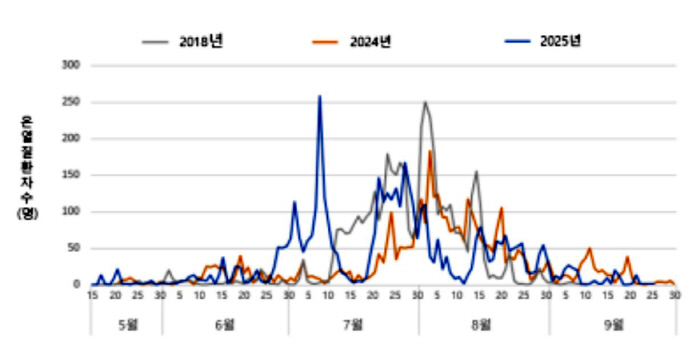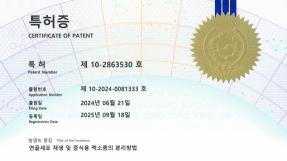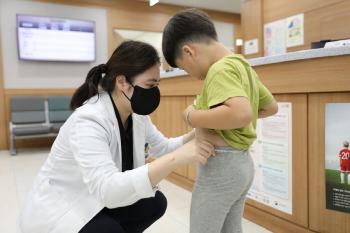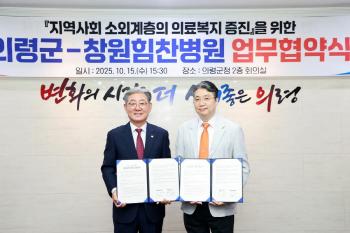4,460 people with heat-related illnesses this summer in the hottest weather ever recorded...20.4% higher than last year
Oct 16, 2025
|
In this heat, many people with heat-related diseases also occurred. Heat illness is an acute disease caused by heat, which shows symptoms such as headache, dizziness, muscle cramps, fatigue, and loss of consciousness when exposed to a hot environment for a long time, and heat stroke and heat exhaustion are typical diseases that can be life-threatening if left unattended.
According to the results of the operation of the emergency room monitoring system for thermal diseases in the summer of 2025 (May 15 to September 25) announced by the Korea Centers for Disease Control and Prevention on the 16th, a total of 4,460 people (29 deaths) were reported, up 20.4% from the previous year (3,704 deaths from thermal diseases and 34 deaths). This is the highest number since 2018 (4,526 people) when the number of heat-related diseases was the highest. The number of deaths was 29, down 14.7% from the previous year (34), and the fourth highest since emergency room monitoring began. The estimated deaths from heat diseases are in the order of 2018 (48), 2024 (34), 2023 (32), and 2025 (29).
29.0% (1,295) of all patients with heat illness occurred in late July, and 34.5% (10) of all deaths (29) occurred in late July. The average maximum temperature in late July 2025 was 33.9℃, 1.8℃ higher than the previous year (32.1℃).
The most common day in 2025 was July 8, with a total of 259 people, and the average maximum temperature was 34.1℃. It was followed by 167 (34.9℃) on July 28 and 147 (32.7℃) on July 22.
As for the main characteristics of patients with heat illness in 2025, men (3,553, 79.7%) occurred about four times more than women (907, 20.3%). By age, 865 people (19.4%) were in their 50s, 834 (18.7%) in their 60s, 608 (13.6%) in their 30s, 603 (13.5%) in their 40s, and 485 (10.9%) in their 70s, and 30.1% of all patients were aged 65 or older. The number of reported patients per 100,000 people was also high among the elderly in their 80s or older.
By region, the number of heat-related diseases was 978 in Gyeonggi-do, 436 in Gyeongbuk, 382 in Gyeongnam, 381 in Jeollanam-do, and 378 in Seoul. The number of reported patients per 100,000 people was 21.4 in Jeollanam-do, 16.9 in Ulsan and Gyeongbuk, and 15.8 in Jeju.
By occupation, simple labor workers accounted for the largest number of workers with 1,160 (26.0%), followed by 589 (13.2%) unemployed and 348 (7.8%).
By disease, heat exhaustion was the most common with 2,767 (62.0%), followed by heat stroke with 667 (15.0%), heat cramps with 613 (13.7%), and heat fainting with 345 (7.7%).
The number of heat-related diseases by place of occurrence was 3,534 (79.2%) outdoors, 3.8 times more than indoors (926 people, 20.8%), followed by 1,431 people (32.1%) in outdoor workplaces, 542 people (12.2%), 522 people (11.7%) on the side of the road, and 445 people (10.0%).
A total of 29 deaths were estimated for heat illness, 23 males and 6 females, and 18 (62.1%) were aged 60 or older. The most common place of occurrence was outdoors with 23 people (79.3%), and the estimated cause of death was heat stroke with 27 people (93.1%). By region, Gyeonggi Province had six, Chungnam five, Gyeongbuk four, and Seoul, Jeonnam, and Gyeongnam three, respectively.
This year, after 2018 (48), which had the highest number of deaths from heat waves, it had the fourth highest number of deaths in 2024, 32 in 2023, and 29 in 2025, with around 30 in the last three years. Of these, 27 (84.4%) were over 60 years old in 2023, 23 (67.6%) in 2024, and 18 (62.1%) in 2025, still accounting for more than 60% of the total, but the trend was decreasing.
Director of the Korea Centers for Disease Control and Prevention Lim Seung-kwan said, "This year, we have strengthened the prevention of heat diseases by strengthening on-site promotional activities with disease response centers in five regions to prevent heat diseases, and by preparing customized rules for the disabled and visiting residential facilities for the disabled. We will continue to develop additional customized prevention manuals for each subject and situation, and make more efforts to minimize public health damage caused by heat waves through guidance to the public."
This article was translated by Naver AI translator.














